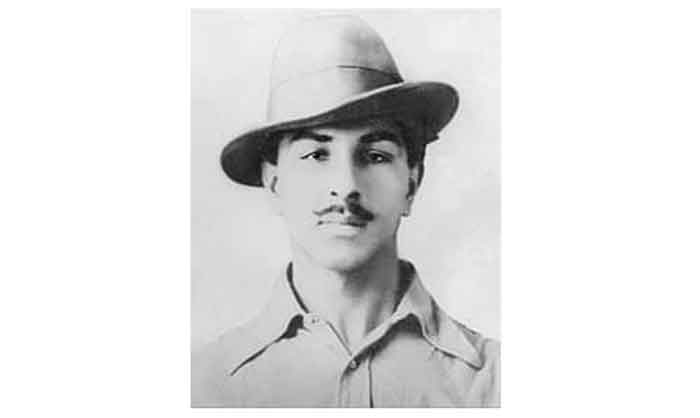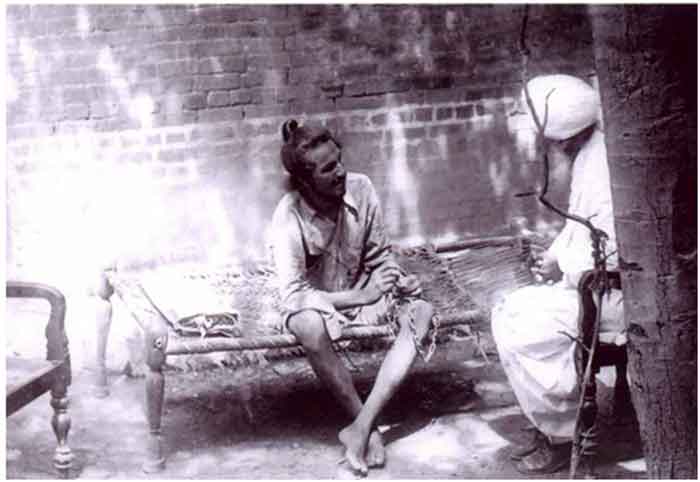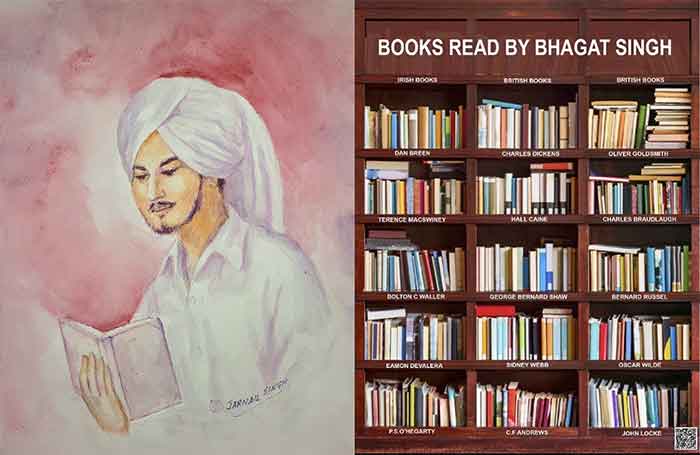
Without doubt Bhagat Singh was one of the greatest revolutionaries, who chalked out a genuine revolutionary anti-colonial programme and not the Indian National Congress. He pioneered the formation of an organisation charting out a programme opposing landlordism, capitalism and imperialism.
Initially he supported the path of individual terrorism and was influenced by the Irish revolutionaries but later after studying Marx and worldwide experiences rejected those methods. It is fascinating how Bhagat Singh received his first baptism evolved into a Marxist and the events that crystallised him to do so. Inspite of not being a member of the Communist party Bhagat Singh recognised that India had a comprador capitalist bourgeoisie as well as national bourgeoisie, unlike the Communist party and that the peasantry would be the main force of the anti colonial struggle. In all spheres be it on caste system, religion, capitalism or science Bhagat Singh’s writings had Marxist Leninist connotations. With great insight and analysis he exposed how the agenda of the Indian national Congress paved no genuine path for the liberation of peasants from bondage of landlordism or of the Workers from capitalist slavery. In the very language of the people he summed up the reactionary nature of religious ideas and why not only was it an opiate of the masses but an instrument to divide and rule the people by the British. Bhagat Singh’s approach was not mechanical in any aspect, unlike the Communist party, and to me it is a blessing in disguise that he was distanced from the then Communist Party of India. This enabled him to cultivate independent thinking and not just toe the line of a Communist leader.Bhagat Singh gave Marxism-Leninism an Indian flavour.
Bhagat Singh gained inspiration from a far wider and deeper source of influences for his convictions than Gandhi ever did when he refers to actions of men such as Washington and Garibaldi, Lafayette and Lenin. This is what moulded Bhagat Singh into the ultimate rationalist in the Indian revolutionary struggle. What distinguished him from other revolutionaries of the time was how, having started off life in the burning embers of insurgent Lyallpur and Lahore, his political development got a 360 degree turn by the vast spectrum of international radical literature into which he was wholeheartedly absorbed and cherished right until the very moment of his hanging. He read not only Marx, Engels and Trotsky but also Thomas Paine, Upton Sinclair, Morris Hillquit and Jack London. He went on to read Victor Hugo, Dostoevsky, Spinoza and Bertrand Russell.
Today with Hindutva fascism at ascendancy as never before there are tendencies wishing to reconcile Gandhiji’s goal with that of Bhagat Singh or project their ideas as similar. Bhagat Singh has also been utilised as a symbol by RSS forces just like the Khalistani leaders did earlier. A most positive development is how the Ambedkaraites recognise Bhagat Singh as a great revolutionary and wish to reconcile Dalit liberation ideology with Bhagat Singh’s writings. Bhagat Singh’s writings are the very instrument to isolate or extinguish the RSS forces and give Hindutva a crippling blow, with its inherent secular and revolutionary content.
A major feature of the revolutionary cultural organisations in the period from 1970’s was exposing how Mahatma Gandhi betrayed Bhagat Singh, to the extent of even purposely not commuting his death sentence. Particularly in Punjab through theatre they exposed how the Congress and Gandhi betrayed Bhagat Singh’s ideals in confronting feudalism , capitalism or even caste system.
Mass organisations led by Communist revolutionary forces with utmost consistency re-publish Bhagat Singh’s writings and conduct rallies or meetings projecting his ideals. The symbol of Bhgat Singh propelled mass movements in all spheres. Significant that the Marxist Leninist formations ressurected the Naujwan Bharat Sabha in the early 1970’s in Punjab .It played major role in the 1974 Lok Sangram rally in Moga. and re-published Bhagat Singhs Writings on ‘Why I am an Atheist.” The movement of the 1970’s of students and youth in Punjab led by Punjab Students Union was not only inspired but in many ways resurrected the ideas of Bhagat Singh. In Bhagat Singh martyrdom commemorations almost one lakh people regularly congregate in Punjab. During the Khalistani movement to combat fundamentalism Bhagat Singh’s ideology was symbolised or projected by communist revolutionary groups. During 1999 elections journal Surkh Rekha printed a special issue of his teaching sin light of revolutionary democratic perspective.
Even other states in India had units formed of Naujwan Bharat Sabha ,that modelled itself on Bhagat Singh’s ideals like Uttar Pradesh, Maharashtra ,Bihar ,Delhi etc.In recent times significant work has been conducted by Bhagat Singh Chatra Morcha to synthesise Bhagat Singh’s ideas with Ambedkarism and sow seeds for anti-feudal movement in villages through go to village campaigns. Culminating Bhgat Singh birth centenary ,A three year campaign was conducted by Jan Chetana or Rahul Foundation of Bhagat Singh Shaheedi yatra in Delhi.Uttar Pradesh and Punjab. An essay competition and cultural programme was staged on in birth centenary in Airport bastis in Mumbai’s Nehru Nagar by a cultural forum linking struggle against GVK project ,to defend their land.
I recommend everyone to read article ‘Bhagat Singh :Beyond his political image’ ,by Jaspal Jassi It illustrates why Bhagat Singh was morally a Marxist-Leninist. Most illustratively he elaborates how Bhagat Singh evolved from a very embryonic stage to grasp Marxism and reject path of Individual terrorism. It also summarises how in practice the Indian National Congress was in striking contrast to the virtues or ideal of Bhagat Singh. The article also projects Bhagat Singh’s profound grasp of nature of revolution in colonies and imperialism on a global scale. I would not be so sure of Bhagat Singh being a Marxist Leninist but was impressed to the very core of Bhagat Singh transcending conventional barriers with such open mindedness and being the slave of no dogma. More than anything Bhagat Singh illustrated how no revolutionary experience could be copied mechanically, unlike the Indian Communists who gave mere lip service to Soviet Russia or later Communist revolutionaries in Naxalbari movement who described Chinese path as the Indian path.
It would be progressive if Bhagat Singh’s writings in every sphere are resurrected in context of liberation from the Hindutva fascism of the Bhartiya Janata Party.His essa y’Why I am an Atheist’ would be a perfect thorn in the flesh for those who want to extinguish scientific thinking and replace it with mythological ideas.. All Marxist, progressive forces must seriously study the experiences of Bhagat Singh .Most important lessons could be imbibed on how to form genuine democratic people’s organisations. His teachings must be applied in context of globalisation, mechanisation and digital age, with the world facing the worst ever capitalist crisis. They must be linked to the day to day burning problems and devised in a people’s language.
The most significant aspect which distinguished Shaheed Bhagat Singh’s communist ideals from those of the middle class nationalist follower was his extricating himself from path of revolutionary terrorism. It enabled him to cultivate proletarian awareness. Some necessary conditions were required for Shaheed Bhagat Singh’s thinking to cover such a distance. The crystallisation of his revolutionary personality was shaped through his deep study of the literature of the revolutionary movements of the world as a whole and by grasping it. Even when he had not become a communist in true sense of the term, his views were based on theoretical foundations. He had been influenced by the thinkers and theoretical commentators of the anarchist movements. As a result, his faith got strengthened that when situations demand revolutionary changes, revolutionary terrorist militant actions do play a tumultuous role and arouse the revolutionary force of the masses into action.
In the absence of a genuine communist party in the country, further development of Shaheed Bhagat Singh was dependent on the prequisite of some essential requirements. One such essential requirement i.e. the contact with the Communist International was not available to him. (When Bhagat Singh was in jail, the Hindustan Socialist Republican Army had planned to send some of its important leaders to Soviet Union but this plan could not be executed). The second means could have been, the positive process of the building of the revolutionary class struggle of the basic classes i.e. of workers and peasants. The Hindustan Socialist Republican Army couldn’t avail the opportunity of going through this practice. The third means could have been the process of contact and theoretical discussions with the communist leaders in the country. Shaheed Bhagat Singh did have this opportunity through his contact with the leaders of the Kirti Kisan Party in Punjab but its limitation was that a high level Marxist theoretical explanation was necessary to impress Bhagat Singh. Despite their other merits the leaders of the Kirti Kisan Party in Punjab were not capable then to the required extent for fulfilling this condition. Sohan Singh Josh has admitted that notwithstanding the rejection of revolutionary terrorism they were not in a position to formulate sound explanation of what distinguished it from Marxism on the basis of accurate theoretical ground (Source – Sohan Singh’s writing, My Encounters with Bhagat Singh)
Basing on the experience of Ireland, Shaheed Bhagat Singh termed revolutionary terrorism “a national idealism devoid of revolutionary content ”, which “despite all circumstances being favorable may be lost in the morass of compromise with imperialism” and he questions the revolutionary intimidators, “Should India still copy Ireland, though it may be possible even then should we”? His overall conclusion is that “Satan of terrorism need not be applauded”.
At that time revolutionary terrorism was not predominant within the communist movement in India. It was represented, generally, by middle class nationalist sections. Nevertheless the above stated comment of Shaheed Bhagat Singh can be compared to some extent with those comments of Lenin which he made regarding the common content of the revolutionary terrorism on the one hand and economism-reformism on the other – as wrong trends within the workers’ movement.
Another example e of great distinction which Shaheed Bhagat Singh makes vis-à-vis dreamy conceptions regarding the role of revolutionary terrorism in creating revolutionary conditions and initiating revolution is found in the draft of revolutionary program issued by him. In this draft he projects the necessary objective and subjective conditions. He mentions three necessary conditions stated by Lenin for the success of October revolution: political economic condition, mental preparation of the masses, and a trained revolutionary party capable of providing leadership in testing times. For him establishment of second and third conditions is the “primary task” of communist activists. He also emphasises the forging of program for practical revolutionary activity, “keeping this issue in mind”. He considers “preparing and mobilizing the masses for militant activity” as the main duty of the activists.
On the question of unity of class political forces for the revolution in the country as well, the thinking of Shaheed Bhagat Singh and his comrades took strong political shape. Regarding the role of workers-peasants as the prop of revolution, the view point of Shaheed Bhagat Singh has been coming under discussions. His comments regarding danger of “betrayal” on the part of Congress and “Indian Capitalism” has quite often remained subject of discussions. However the important thing is that the writings of Shaheed Bhagat Singh and his comrades critically made a diagnosis of the role of imperialist capital in the Indian economy as well as its political implications. It has been clearly stated in these writings that with the import of imperialist capital the layer of big capitalists tied in a relation of common interests and servility to it, on the one hand goes on developing and on the other hand the “deterioration” of this layer in respect of defending national interests becomes inevitable. The inclination of this thinking of Shaheed Bhagat Singh comes in conflict with the path of anti-imperialist united front with the entire capitalist class which, later on, determined the limitations of the revolutionary leading role of the Communist Party of India.
It is fascinating that Shaheed Bhagat Singh and his comrades seem inclined towards rectifying the misconception of considering the entire bourgeois class as counter revolutionary. As mentioned earlier, they have used the word “big bourgeois” for the bourgeoisie strung in respect of ties or links with foreign capital. On the other hand such comments are there which point towards strangling of the independent development of capitalism in India owing to imperialist domination and thus become indications of the existence of capitalist class having conflicting interests with foreign capital. The behaviour of British imperialists towards the company of Gurdit Singh Kamagatamaru has been cited as a significant instance of antagonistic relation between imperialist domination and Indian capital.
No doubt certain ideological limitations prevailed.. Shaheed Bhagat Singh’s warnings about the betrayal by capitalist class and Congress were shaped by his goal of seizing state power through revolution and using it as an immediate weapon for the establishment of socialism. On the basis of his Marxist understanding he had already rejected the objective of establishing capitalist state modelled on European countries and America. The concept of anti-imperialist anti-feudal revolution in the imperialist dominated countries under the leadership of working class, as not being a proletarian dictatorship or solely of a worker-peasant state, instead being the common democratic dictatorship of all revolutionary classes and the concept of a united front of all revolutionary classes including the national bourgeoisie for such a revolution, lit is first spark through the experience of Chinese revolution.
The important writings of the Communist International regarding the question of revolution in the imperialist-dominated countries were not then accessible to Shaheed Bhagat Singh. Lenin had been emphatically affirming in connection with the imperialist-dominated backward countries that socialism cannot be immediately imposed upon these countries. He asserted that readymade books of Marxism should not be boldly followed the communists of these countries. They would have to chalk out their own concrete path for their revolutions by digging deep with their conditions. Of course the leadership of the Communist Party of India did throw light to these warnings by Lenin against “imposing” communism but it failed in designing a correct course for the Indian revolution through hard mental labour. Instead the Lenin’s warnings were a tool for justification for forming united front with the big bourgeoisie loyal to imperialism, in the name of anti-imperialist united front and even for accepting its leading role.
It is debatable whether Gandhi was a true nationalist seeking to liberate India from the British but there is no doubt that at important junctures Gandhi compromised uprisings of peasants and Workers ,giving tacit support to Industrialist and landlord classes. Unlike Bhagat Singh Gandhi’s writings had powerful Hindu connotation supporting varnas or caste system or even the Bhagavad Gita.In’ India and the Raj’ Suniti Kumar Ghosh describes how Gandhi so much feared Bhagat Singh that he deliberately rejecting commuting of the sentence .This is amply shown also in the movie ‘The Legend of Shaheed Bhagat Singh ‘enacted by Ajay Devgan.I deeply regret that today even progressive intellectuals distort history by claiming that Gandhi went out of the way to save Bhagat Singh.
Quoting Satwinder Juss “How should we interpret Bhagat Singh? Was he similar to Frantz Fannon? Moreover, although Bhagat Singh is associated with violence, his position changes, and there is no explicit meditation on the redemptive power of ‘killing the colonizer’ as we see articulated in Fanon’s Wretched of the Earth. It is enough to note the continuities, and indeed the differences, between Bhagat Singh and the later Fanon, but Bhagat Singh should be analysed on his own grounds and in his own context, without the need to attach him to another, such as the ‘Indian Che’ or the ‘Indian Lenin’. That does not explain why he is unknown in the West, and nor is it to excuse it, but it is to emphasize how it is all the more important that this lacuna be rectified. One way to do this is to capture the essence of Bhagat Singh in his scattered and fragmented writings, in an attempt at intellectual reconstruction, so that alternative ways of thinking about his importance can be brought out.”
I recommend all readers to read “Bhagat Singh :A life in Revolution’ by Satwinder Juss which is one of the most accurate historical portrayals of this revolutionary icon. The volume summarises upon his family from before when he was born, evaluating the role that various episodes, policies and people played in shaping the identity of a legendary revolutionary, while also probing into his opinions on important questions of the time. Amar Kant Jttu’s book, Walking With Bhagat Singh Soon After Independence, is another informative book that focuses on his revolutionary ideas and interprets his thoughts in the Marxist tradition. Jittu has claimed that this book is an effort to critically analyze the three most popular icons of the freedom struggle of India– Mahatma Gandhi, Jawaharlal Nehru and Bhagat Singh — from the prism of revolutionaries. The author thinks all three to be geniuses but opines that Gandhi and Nehru are superabundantly glorified, whereas Bhagat Singh has not been given his due. The author is very critical of Gandhi, especially his support to the British colonial regime in suppressing Garhwali Rifles led by Chandra Singh Garhwali, who had refused to fire at peaceful protesters of the 1930 non-cooperation movement at Peshawar and the 1946 Royal Indian Navy revolt.
It is intriguing how Bhagat Singh would have shaped India had he lived on when you assess his phenomenal impact on the Indian psyche, being voted a s a greater icon o more popular than even M.K.Gandhi.His originality would have wiped out dogmatism and given Marxism an Indian brand.
Harsh Thakor is a freelance Journalist who has researched on Bhagat Singh












































